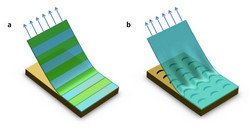Understanding the failure behaviour of heterogeneous materials
The continuum mechanics concepts that underlie the current theory of fracture do not take into account the central role played by material heterogeneities. However, material failure is a result of the complex interplay between the stress loads applied at the large scale and the progressive damage of the material's microstructure at the small scale. Within the EU-funded project TOUGHBRIDGE (Bridging microstructural to macroscopic properties in failure of heterogeneous materials), scientists enriched the classical fracture mechanics theory with concepts from statistical physics. In their approach, macroscopic failure emerges from the collective response of a field of damage that spreads through the material at the microstructure scale. Specifically, they showed that the interplay between the material disorder and the stress redistribution after the occurrence of a damage event plays a central role in controlling the failure properties of solids. And following this idea, they could develop models able to capture the failure response of materials from the knowledge of their heterogeneous microstructure. These new theoretical concepts were developed thanks to the numerical and experimental study of failure in heterogeneous solids with simple and controlled microstructures. For their experiments, the scientists had to design new set-ups and develop new means of observation that allowed them to follow cracks propagating in materials at small length and time scale. They used a statistical treatment of the raw data collected that offered them a better understanding of the physics and mechanics of fracture. Finally, the new theoretical approaches developed within this project to describe the transition to failure in materials were confronted and tested towards experimental observations. Overall, these new approaches have proved to predict efficiently the failure behaviour and the resistance of a large range of materials. Indeed, the scientists have already successfully employed them to estimate the failure properties of heterogeneous brittle materials that break through the propagation of a single crack or the one of quasi-brittle materials that break through the spreading of an ensemble of microcracks. Aside from the better understanding of fracture, work carried out within the TOUGHBRIDGE project has led to new ways to design materials with improved mechanical properties. This ‘failure by design’ concept was applied for making heterogeneous thin films with new adhesive properties. The next step is to design tougher and lighter heterogeneous solids, taking advantage of the recent progresses in 3D printing techniques that allow the full control of the material architecture. This new approach for the design of tougher materials opens many interesting perspectives for technological applications.




